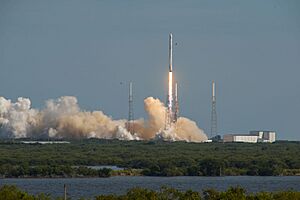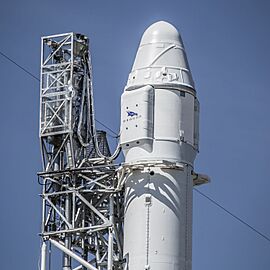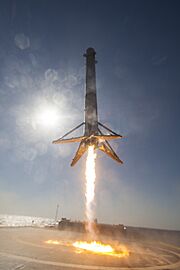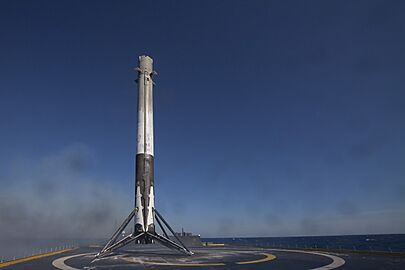SpaceX CRS-8 facts for kids
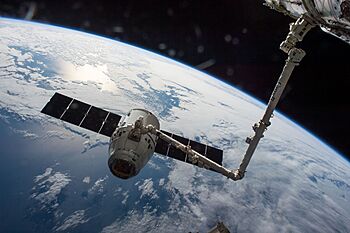
The CRS-8 SpaceX Dragon captured by Canadarm on April 10, 2016
|
|
| Names | SpX-8 |
|---|---|
| Mission type | ISS resupply |
| Operator | SpaceX |
| Mission duration | 32 days, 21 hours, 48 minutes |
| Spacecraft properties | |
| Spacecraft | Dragon C110 |
| Spacecraft type | Dragon 1 |
| Manufacturer | SpaceX |
| Start of mission | |
| Launch date | April 8, 2016, 20:43 UTC |
| Rocket | Falcon 9 Full Thrust (B1021) |
| Launch site | Cape Canaveral, SLC-40 |
| Contractor | SpaceX |
| End of mission | |
| Disposal | Recovered |
| Landing date | May 11, 2016, 18:31 UTC |
| Landing site | Pacific Ocean |
| Orbital parameters | |
| Reference system | Geocentric |
| Regime | Low Earth |
| Periapsis | 402 km (250 mi) |
| Apoapsis | 405 km (252 mi) |
| Inclination | 51.64 degrees |
| Period | 92.63 minutes |
| Epoch | May 10, 2016, 13:19:38 UTC |
| Berthing at ISS | |
| Berthing port | Harmony nadir |
| RMS capture | April 10, 2016, 11:23 UTC |
| Berthing date | April 10, 2016, 13:57 UTC |
| Unberthing date | May 11, 2016, 11:00 UTC |
| RMS release | May 11, 2016, 13:19 UTC |
| Time berthed | 30 days, 21 hours, 3 minutes |
| Cargo | |
| Mass | 3,136 kg (6,914 lb) |
| Pressurised | 1,723 kg (3,799 lb) |
| Unpressurised | 1,413 kg (3,115 lb) |
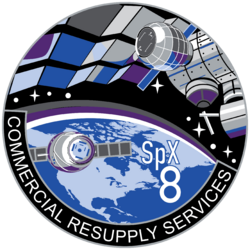 NASA SpX-8 mission patch Commercial Resupply Services
|
|
SpaceX CRS-8, also known as SpX-8, was a special space mission. It was a supply mission to the International Space Station (ISS). The mission launched on April 8, 2016.
This was the tenth flight of a Dragon cargo spacecraft. It was also the eighth mission that NASA hired SpaceX to do. The Dragon capsule carried over 3,100 kilograms (6,800 pounds) of supplies.
A very important part of its cargo was the Bigelow Expandable Activity Module (BEAM). This was a test version of an inflatable space habitat. It was carried in the Dragon's back section. BEAM was attached to the space station. It is still there, being tested for many years.
After launching the Dragon into space, the rocket's first part came back to Earth. It landed upright on a special ship in the ocean. This was a huge step for SpaceX's goal to reuse rockets.
The rocket part that landed, called B1021, was used again. It launched another satellite in 2017. This was the first time a rocket part was reused for a new mission.
Contents
Launching into Space
The launch of CRS-8 happened on April 8, 2016, exactly as planned. The Falcon 9 rocket lifted off at 8:43 PM UTC.
About 2 minutes and 40 seconds after launch, the first part of the rocket separated. The second part of the rocket then continued into space. It separated about 10 minutes and 30 seconds after liftoff.
What the Dragon Carried
The Dragon spacecraft delivered 3,136 kilograms (6,914 pounds) of supplies to the ISS. These supplies included scientific experiments and new equipment.
- BEAM: One of the main items was the Bigelow Expandable Activity Module (BEAM). This was the first inflatable module for the space station. It is being tested to see how well it works in space.
- CubeSats: The Dragon also carried sixteen small satellites called 3U CubeSats. These were for observing Earth. They were later released from the station.
After its mission, the Dragon capsule returned to Earth. It brought back over 3,700 pounds (1,700 kilograms) of cargo from the space station. This included finished experiments and old equipment.
Rocket Landing: A Big Step
After sending the Dragon capsule towards the International Space Station, the first part of the Falcon 9 rocket (called B1021) came back to Earth. It performed a special maneuver over the Atlantic Ocean.
Nine minutes after launching, the rocket part landed upright. It landed on a ship called Of Course I Still Love You. This ship was about 300 kilometers (186 miles) from the coast of Florida. This landing was a huge success for SpaceX. It showed that they could land and reuse their rockets.
This was the second time SpaceX successfully landed a rocket. It was the first time any company landed a rocket vertically on a floating ship. SpaceX had landed a Falcon 9 on solid ground in Florida a few months earlier.
Rocket's Return to Port
The drone ship brought the landed rocket part to Port Canaveral, Florida. It arrived on April 12, 2016. SpaceX planned to keep this rocket part in Cape Canaveral. They wanted to test its engines to make sure it was ready for another mission.
SpaceX CEO Elon Musk said the rocket would likely be tested. If the tests went well, it could be used again for a mission in June 2016.
First Rocket Reused
The first part of the CRS-8 rocket was chosen to be reused first. This happened in early 2017. More tests were done to make sure it was safe to fly again.
On January 31, 2017, SpaceX shared a photo of a test of this rocket part. It was launched again on March 30, 2017. This time, it carried the SES-10 satellite. The rocket part was also recovered a second time. It landed again on the same drone ship, Of Course I Still Love You.
Gallery
- SpaceX CRS-8
See also
- List of Falcon 9 launches


